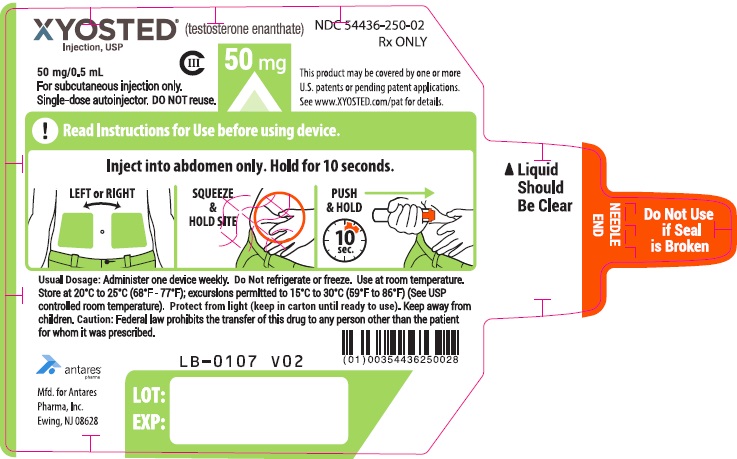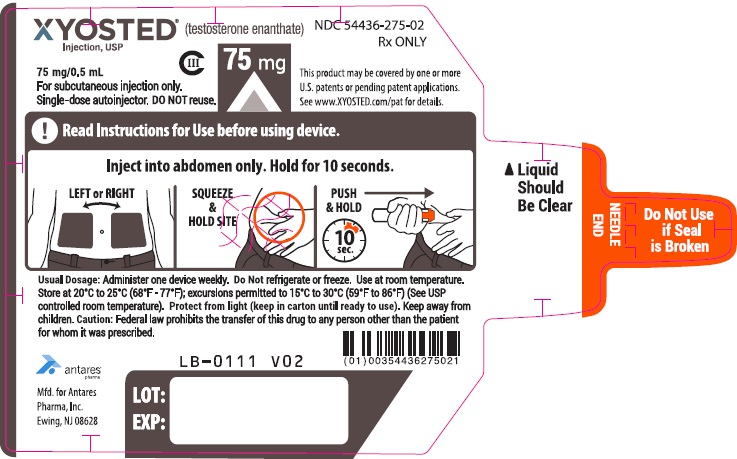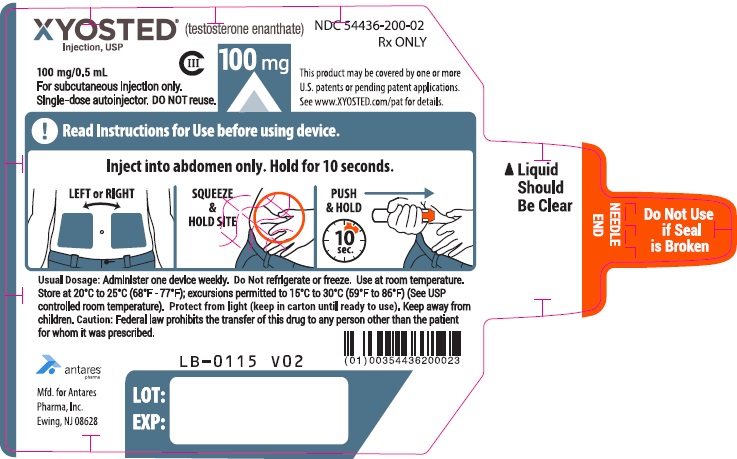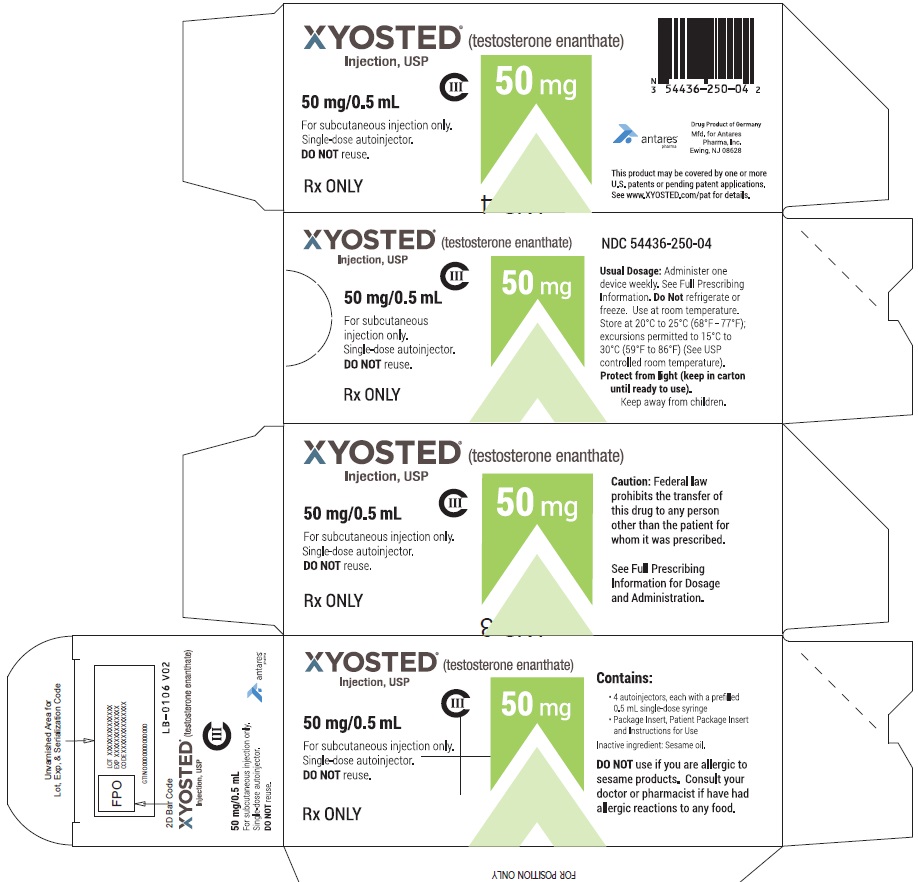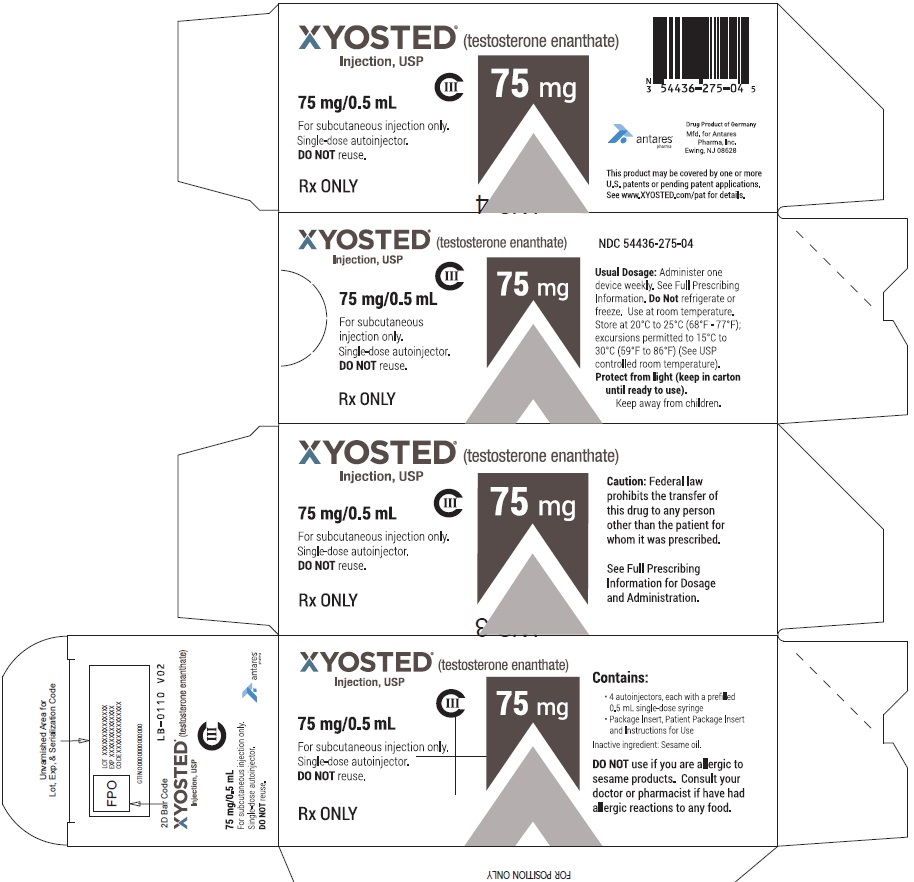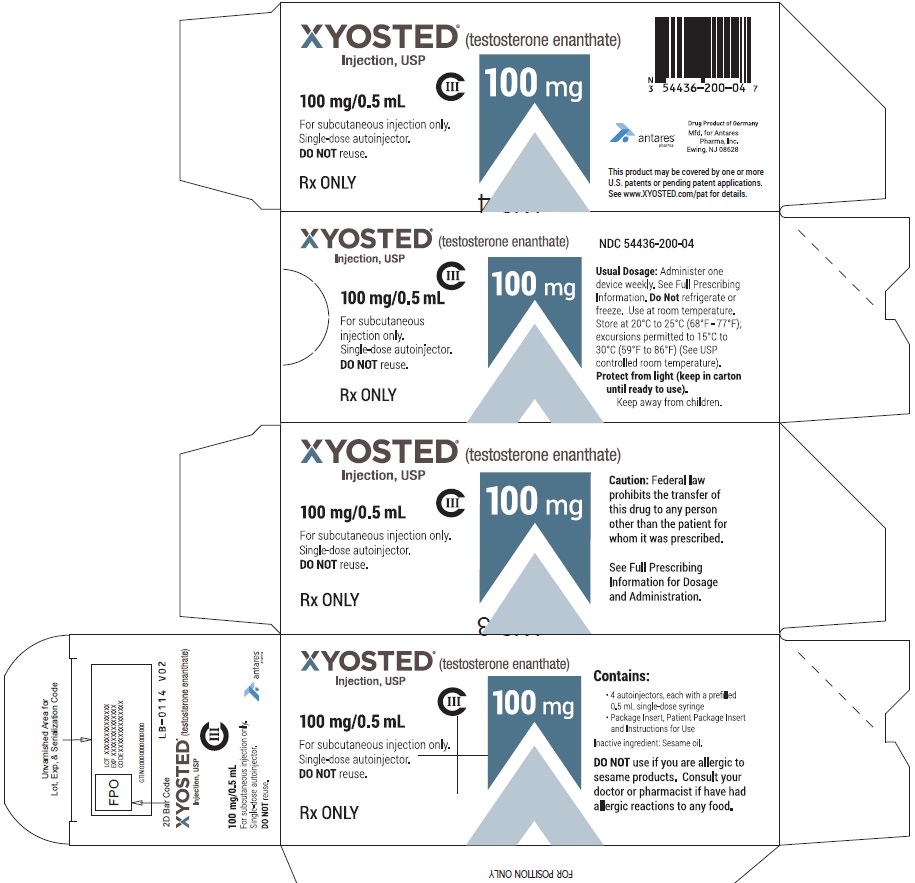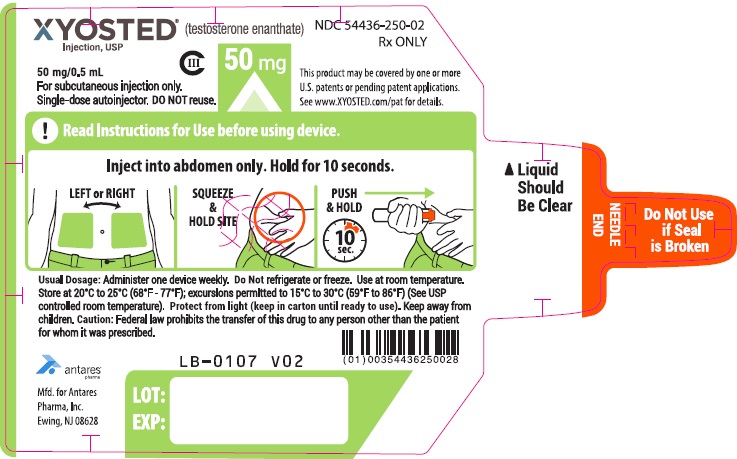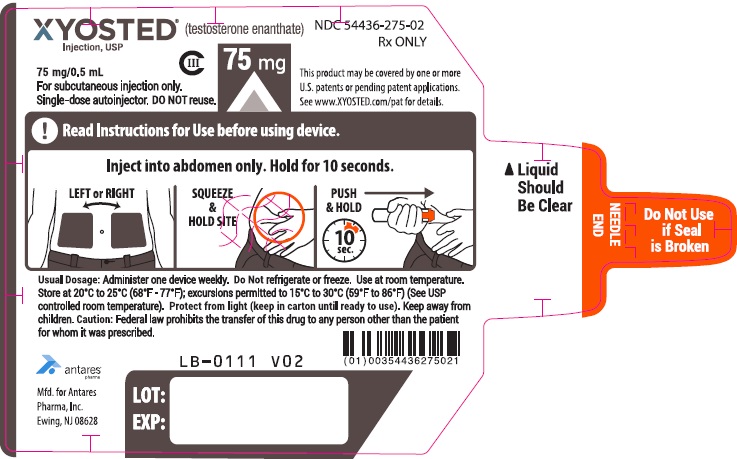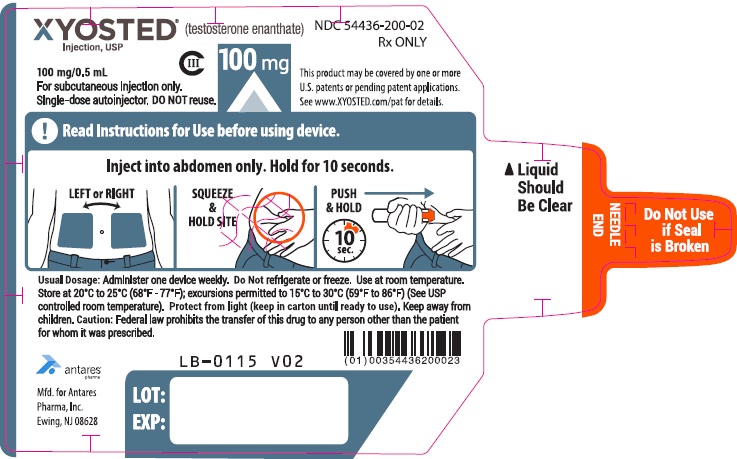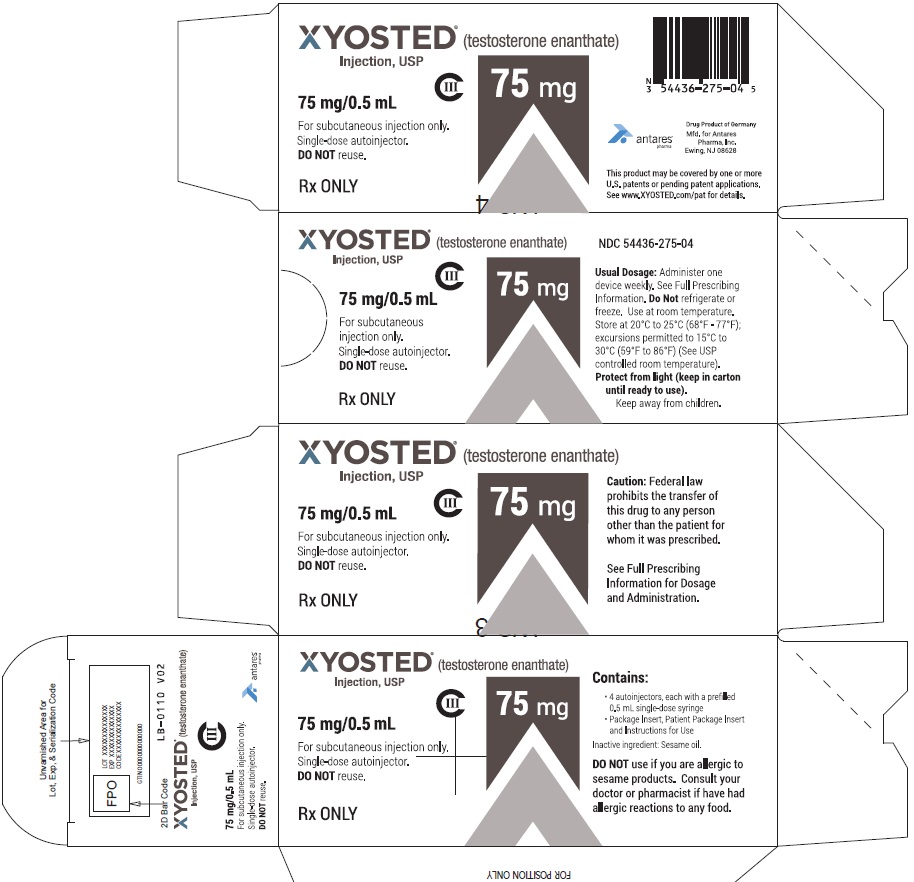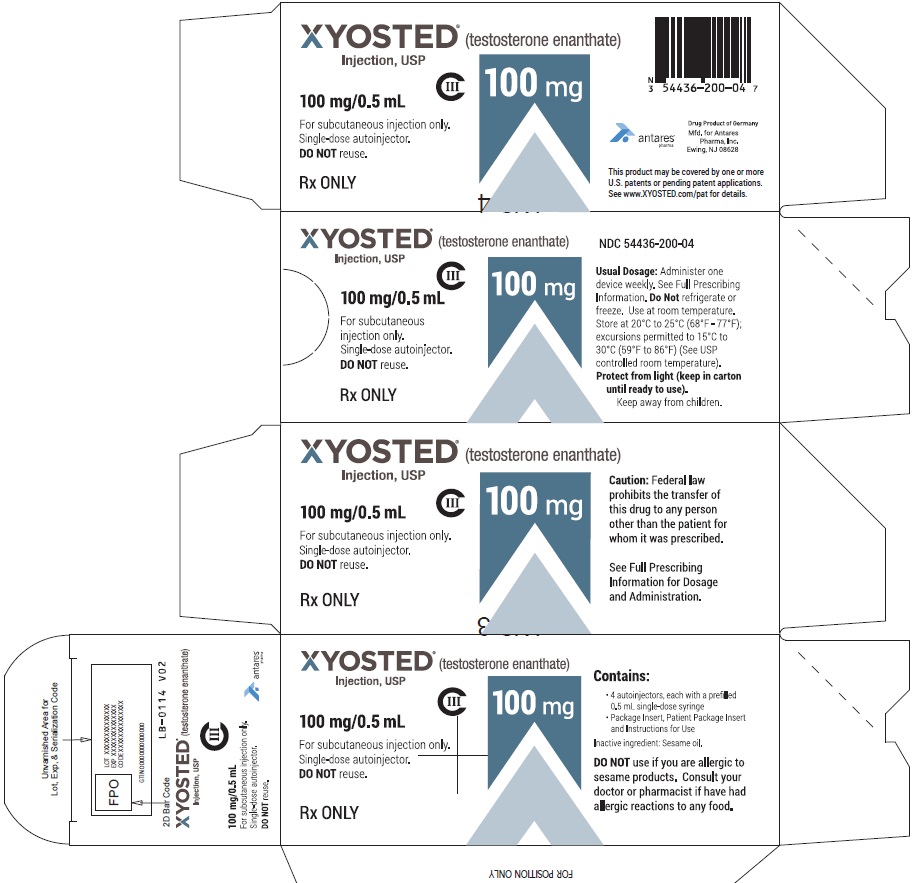Label: XYOSTED- testosterone enanthate injection
-
NDC Code(s):
54436-200-01,
54436-200-02,
54436-200-03,
54436-200-04, view more54436-200-05, 54436-250-01, 54436-250-02, 54436-250-03, 54436-250-04, 54436-275-01, 54436-275-02, 54436-275-03, 54436-275-04, 54436-275-05
- Packager: Antares Pharma, Inc.
- Category: HUMAN PRESCRIPTION DRUG LABEL
- DEA Schedule: CIII
- Marketing Status: New Drug Application
Drug Label Information
Updated January 4, 2024
If you are a consumer or patient please visit this version.
- Download DRUG LABEL INFO: PDF XML
- Medication Guide: HTML
- Official Label (Printer Friendly)
-
HIGHLIGHTS OF PRESCRIBING INFORMATION
These highlights do not include all the information needed to use XYOSTED® safely and effectively. See full prescribing information for XYOSTED.
XYOSTED (testosterone enanthate) injection, for subcutaneous use
CIII
Initial U.S. approval: 1953WARNING: BLOOD PRESSURE INCREASES
See full prescribing information for complete boxed warning
- XYOSTED can cause blood pressure (BP) increases that can increase the risk of major adverse cardiovascular events (MACE), including non-fatal myocardial infarction, non-fatal stroke and cardiovascular death (5.1, 6.1).
- Before initiating XYOSTED, consider the patient’s baseline cardiovascular risk and ensure blood pressure is adequately controlled.
- Periodically monitor for and treat new-onset hypertension or exacerbations of pre-existing hypertension and re-evaluate whether the benefits of XYOSTED outweigh its risks in patients who develop cardiovascular risk factors or cardiovascular disease on treatment.
- Due to this risk, use XYOSTED only for the treatment of men with hypogonadal conditions associated with structural or genetic etiologies (1, 4).
INDICATIONS AND USAGE
XYOSTED (testosterone enanthate) injection is an androgen indicated for testosterone replacement therapy in adult males for conditions associated with a deficiency or absence of endogenous testosterone (1).
Limitations of Use:
DOSAGE AND ADMINISTRATION
- Prior to initiating XYOSTED: confirm the diagnosis of hypogonadism by ensuring that serum testosterone has been measured in the morning on at least two separate days and that these concentrations are below the normal range (2.1).
- Starting dose: 75 mg subcutaneously in the abdominal region once weekly. Avoid intramuscular and intravascular administration (2.2, 2.3).
- Dose Adjustment: Based upon total testosterone trough concentrations (measured 7 days after most recent dose) obtained following 6 weeks of dosing and periodically thereafter (2.2).
DOSAGE FORMS AND STRENGTHS
- XYOSTED (testosterone enanthate) Injection is supplied as 0.5 mL of sterile solution in an autoinjector for subcutaneous administration in three strengths (3):
- 50 mg/0.5 mL
- 75 mg/0.5 mL
- 100 mg/0.5 mL
CONTRAINDICATIONS
- Men with carcinoma of the breast or known or suspected carcinoma of the prostate (4, 5.4).
- Women who are pregnant (4, 8.1). Testosterone may cause fetal harm (4, 5.7, 8.1, and 8.2).
- Known hypersensitivity to XYOSTED or its ingredients (4).
- Men with hypogonadal conditions not associated with structural or genetic etiologies (1, 4)
WARNINGS AND PRECAUTIONS
- Monitor hematocrit approximately every 3 months to detect increased red blood cell mass and polycythemia (5.2).
- Monitor patients with benign prostatic hyperplasia (BPH) for worsening signs and symptoms of BPH (5.4).
- Venous thromboembolism (VTE), including deep vein thrombosis (DVT) and pulmonary embolism (PE) have been reported in patients using testosterone products. Evaluate patients with signs or symptoms consistent with DVT or PE (5.5).
- Testosterone has been subject to abuse, typically at doses higher than recommended for the approved indication and in combination with other anabolic androgenic steroids (5.6).
- Exogenous administration of androgens may lead to azoospermia (5.8).
- Edema with or without congestive heart failure may be a complication in patients with preexisting cardiac, renal, or hepatic disease (5.10).
- Sleep apnea may occur in those with risk factors (5.12).
- Monitor prostatic specific antigen (PSA) and lipid concentrations periodically (5.4, 5.13).
- Depression and suicidal ideation and behavior, including completed suicide, have occurred during clinical trials in patients treated with XYOSTED (5.16).
ADVERSE REACTIONS
The most commonly reported adverse reactions (>5%) were: hematocrit increased, hypertension, PSA increased, injection site bruising, and headache. (6.1)
To report SUSPECTED ADVERSE REACTIONS, contact Antares at 1-844-XYOSTED (1-844-996-7833) or FDA at 1-800-FDA-1088 or www.fda.gov/medwatch.
DRUG INTERACTIONS
- Androgens may decrease blood glucose, and therefore may decrease insulin requirements in diabetic patients (7.1).
- Changes in anticoagulant activity may be seen with androgens. More frequent monitoring of international normalized ratio (INR) and prothrombin time is recommended in patients taking warfarin (7.2).
- Use of testosterone with corticosteroids may result in increased fluid retention. Use with caution, particularly in patients with cardiac, renal, or hepatic disease (7.3).
- Concomitant administration of medications that are known to increase BP with XYOSTED may lead to additional increases in BP (7.4).
USE IN SPECIFIC POPULATIONS
- Geriatric Patients: There are insufficient long-term safety data to assess the potential risks of cardiovascular disease and prostate cancer (8.5).
See 17 for PATIENT COUNSELING INFORMATION and Medication Guide.
Revised: 8/2023
-
Table of Contents
FULL PRESCRIBING INFORMATION: CONTENTS*
WARNING: BLOOD PRESSURE INCREASES
1 INDICATIONS AND USAGE
2 DOSAGE AND ADMINISTRATION
2.1 Confirmation of Hypogonadism Before Initiation of XYOSTED
2.2 Starting Dose and Dose Adjustment
2.3 Important Administration Instructions
3 DOSAGE FORMS AND STRENGTHS
4 CONTRAINDICATIONS
5 WARNINGS AND PRECAUTIONS
5.1 Blood Pressure Increases
5.2 Polycythemia
5.3 Cardiovascular Risk
5.4 Worsening of Benign Prostatic Hyperplasia (BPH) and Potential Risk of Prostate Cancer
5.5 Venous Thromboembolism
5.6 Abuse of Testosterone and Monitoring of Serum Testosterone Concentrations
5.7 Not for Use in Women
5.8 Potential for Adverse Effects on Spermatogenesis
5.9 Hepatic Adverse Effects
5.10 Edema
5.11 Gynecomastia
5.12 Sleep Apnea
5.13 Lipids
5.14 Hypercalcemia
5.15 Decreased Thyroxine-binding Globulin
5.16 Risk of Depression and Suicide
6 ADVERSE REACTIONS
6.1 Clinical Trials Experience
7 DRUG INTERACTIONS
7.1 Insulin
7.2 Oral Anticoagulants
7.3 Corticosteroids
7.4 Medications that May Also Increase Blood Pressure
8 USE IN SPECIFIC POPULATIONS
8.1 Pregnancy
8.2 Lactation
8.3 Females and Males of Reproductive Potential
8.4 Pediatric Use
8.5 Geriatric Use
9. DRUG ABUSE AND DEPENDENCE
9.1 Controlled Substance
9.2 Abuse
9.3 Dependence
10 OVERDOSAGE
11 DESCRIPTION
12 CLINICAL PHARMACOLOGY
12.1 Mechanism of Action
12.2 Pharmacodynamics
12.3 Pharmacokinetics
13 NONCLINICAL TOXICOLOGY
13.1 Carcinogenesis, Mutagenesis, Impairment of Fertility
14 CLINICAL STUDIES
16 HOW SUPPLIED/STORAGE AND HANDLING
16.1 How Supplied
16.2 Storage and Handling
17 PATIENT COUNSELING INFORMATION
Increased Blood Pressure and Risk for Major Adverse Cardiovascular Events (MACE)
Other Adverse Reactions
- *
- Sections or subsections omitted from the full prescribing information are not listed.
-
BOXED WARNING
(What is this?)
WARNING: BLOOD PRESSURE INCREASES
- XYOSTED can cause blood pressure (BP) increases that can increase the risk for major adverse cardiovascular events (MACE), including non-fatal myocardial infarction, non-fatal stroke and cardiovascular death, with greater risk for MACE in patients with cardiovascular risk factors or established cardiovascular disease [see Warnings and Precautions (5.1) and Adverse Reactions (6.1)].
- Before initiating XYOSTED, consider the patient’s baseline cardiovascular risk and ensure blood pressure is adequately controlled.
- Starting approximately 6 weeks after initiating therapy, periodically monitor for and treat new-onset hypertension or exacerbations of pre-existing hypertension in patients on XYOSTED.
- Re-evaluate whether the benefits of XYOSTED outweigh its risks in patients who develop cardiovascular risk factors or cardiovascular disease while on treatment.
- Due to this risk, use XYOSTED only for the treatment of men with hypogonadal conditions associated with structural or genetic etiologies [see Indications and Usage (1) and Contraindications (4)].
-
1 INDICATIONS AND USAGE
XYOSTED (testosterone enanthate) injection is an androgen indicated for testosterone replacement therapy in adult males for conditions associated with a deficiency or absence of endogenous testosterone.
- Primary hypogonadism (congenital or acquired): testicular failure due to cryptorchidism, bilateral torsion, orchitis, vanishing testis syndrome, orchiectomy, Klinefelter's syndrome, chemotherapy, or toxic damage from alcohol or heavy metals. These men usually have low serum testosterone concentrations and gonadotropins (follicle-stimulating hormone [FSH], luteinizing hormone [LH]) above the normal range.
- Hypogonadotropic hypogonadism (congenital or acquired): gonadotropin or luteinizing hormone-releasing hormone (LHRH) deficiency or pituitary-hypothalamic injury from tumors, trauma, or radiation. These men have low testosterone serum concentrations but have gonadotropins in the normal or low range.
Limitations of Use:
- Safety and efficacy of XYOSTED in males less than 18 years old have not been established [see Use in Specific Populations (8.4)].
-
2 DOSAGE AND ADMINISTRATION
2.1 Confirmation of Hypogonadism Before Initiation of XYOSTED
Prior to initiating XYOSTED, confirm the diagnosis of hypogonadism by ensuring that serum testosterone concentrations have been measured in the morning on at least two separate days and that these serum testosterone concentrations are below the normal range.
2.2 Starting Dose and Dose Adjustment
The starting dose of XYOSTED is 75 mg, administered subcutaneously in the abdominal region once a week.
Dose adjustment
Measure total testosterone trough concentrations (measured 7 days after the most recent dose) following 6 weeks of dosing, following 6 weeks after dose adjustment, and periodically while on treatment with XYOSTED. A trough concentration between 350 ng/dL and 650 ng/dL generally provides testosterone exposures in the normal range during the entire dosing interval.
Decrease the dose by 25 mg if the total testosterone trough concentration (Ctrough) is ≥650 ng/dL.
Increase the dose by 25 mg if the total testosterone Ctrough is <350 ng/dL.
Maintain the same dose if the total testosterone Ctrough is ≥350 ng/dL and <650 ng/dL.2.3 Important Administration Instructions
XYOSTED is for subcutaneous injection in the abdominal region only. Avoid intramuscular or intravascular injection.
Instruct patients on the proper use of XYOSTED and direct them to use the proper injection site. Refer to the Instructions for Use for proper use of XYOSTED.
Visually inspect XYOSTED for particulate matter and discoloration prior to administration. Do not use if the liquid is cloudy or if visible particles are present.
Do not use XYOSTED if the seal is broken.
-
3 DOSAGE FORMS AND STRENGTHS
XYOSTED injection is available as 0.5 mL of a sterile, preservative-free and nonpyrogenic, clear, colorless to yellow solution containing testosterone enanthate. It is supplied in a single-dose syringe assembled in an autoinjector for subcutaneous administration. XYOSTED is available in three dosage strengths:
50 mg/0.5 mL
75 mg/0.5 mL
100 mg/0.5 mL
-
4 CONTRAINDICATIONS
XYOSTED is contraindicated in:
- Men with carcinoma of the breast or known or suspected carcinoma of the prostate [see Warnings and Precautions (5.4)].
- Women who are pregnant. Testosterone can cause virilization of the female fetus when administered to a pregnant woman [see Use in Specific Populations (8.1)].
- Men with known hypersensitivity to XYOSTED or any of its ingredients (testosterone enanthate and sesame oil).
- Men with hypogonadal conditions, such as “age-related hypogonadism”, that are not associated with structural or genetic etiologies. The efficacy of XYOSTED has not been established for these conditions, and XYOSTED can increase BP that can increase the risk of MACE [see Boxed Warning and Warning and Precautions (5.1)].
-
5 WARNINGS AND PRECAUTIONS
5.1 Blood Pressure Increases
In clinical trials, XYOSTED increased systolic BP in the first 12 weeks of treatment by an average of 4 mmHg based on ambulatory blood pressure monitoring (ABPM) and by an average of 4 mmHg from baseline following 1 year of treatment based on blood pressure cuff measurements [see Adverse Reactions (6.1)]. In the one-year trial, 10% of XYOSTED-treated patients were started on antihypertensive medications or required changes to their antihypertensive medication regimen.
These BP increases can increase the risk of MACE, with greater risk in patients with established cardiovascular disease or risk factors for cardiovascular disease [see Boxed Warning].
In some patients, the increase in BP with XYOSTED may be too small to detect, but can still increase the risk for MACE.
Before initiating XYOSTED, consider the patient’s baseline cardiovascular risk and ensure blood pressure is adequately controlled. Check BP approximately 6 weeks after initiating XYOSTED and periodically thereafter. Treat new-onset hypertension or exacerbations of pre-existing hypertension. Re-evaluate whether the benefits of continued treatment with XYOSTED outweigh its risks in patients who develop cardiovascular risk factors or cardiovascular disease.
5.2 Polycythemia
Increases in hematocrit reflective of increases in red blood cell mass may require discontinuation of XYOSTED.
Check that hematocrit is not elevated prior to initiating XYOSTED. Evaluate hematocrit approximately every 3 months while the patient is on XYOSTED. If hematocrit becomes elevated, stop XYOSTED until the hematocrit decreases to an acceptable level. If XYOSTED is restarted and again causes hematocrit to become elevated, stop XYOSTED permanently. An increase in red blood cell mass may increase the risk of thromboembolic events.
5.3 Cardiovascular Risk
Long term clinical safety trials have not been completed to assess the cardiovascular outcomes of testosterone replacement therapy in adult males. To date, epidemiologic studies and randomized controlled trials have been inconclusive for determining the risk of MACE, such as non-fatal myocardial infarction, non-fatal stroke, and cardiovascular death, with the use of testosterone compared to non-use. Some studies, but not all, have reported an increased risk of MACE in association with use of testosterone replacement therapy in adult males. XYOSTED can cause BP increases that can increase the risk of MACE [see Boxed Warning and Warnings and Precautions (5.1)]. Patients should be informed of this possible risk when deciding whether to use or to continue to use XYOSTED.
5.4 Worsening of Benign Prostatic Hyperplasia (BPH) and Potential Risk of Prostate Cancer
Patients with BPH treated with androgens are at an increased risk of worsening of signs and symptoms of BPH. Monitor patients with BPH for worsening signs and symptoms.
Patients treated with androgens may be at an increased risk for prostate cancer. Evaluate patients for prostate cancer prior to initiating and during treatment with androgens [see Contraindications (4)].
5.5 Venous Thromboembolism
There have been postmarketing reports of venous thromboembolic events, including deep vein thrombosis (DVT) and pulmonary embolism (PE), in patients using testosterone products, such as XYOSTED. Evaluate patients who report symptoms of pain, edema, warmth and erythema in the lower extremity for DVT and those who present with acute shortness of breath for PE. If a venous thromboembolic event is suspected, discontinue treatment with XYOSTED and initiate appropriate workup and management.
5.6 Abuse of Testosterone and Monitoring of Serum Testosterone Concentrations
Testosterone has been subject to abuse, typically at doses higher than recommended for the approved indication and in combination with other anabolic androgenic steroids. Anabolic androgenic steroid abuse can lead to serious cardiovascular and psychiatric adverse reactions [see Drug Abuse and Dependence (9)].
If testosterone abuse is suspected, check serum testosterone concentrations to ensure they are within therapeutic range. However, testosterone levels may be in the normal or subnormal range in men abusing synthetic testosterone derivatives. Counsel patients concerning the serious adverse reactions associated with abuse of testosterone and anabolic androgenic steroids. Conversely, consider the possibility of testosterone and anabolic androgenic steroid abuse in suspected patients who present with serious cardiovascular or psychiatric adverse events.
5.7 Not for Use in Women
Due to lack of controlled studies in women and potential virilizing effects, XYOSTED is not indicated for use in women [see Contraindications (4) and Use in Specific Populations (8.1, 8.2)].
5.8 Potential for Adverse Effects on Spermatogenesis
With large doses of exogenous androgens, including XYOSTED, spermatogenesis may be suppressed through feedback inhibition of pituitary follicle-stimulating hormone (FSH) which could possibly lead to adverse effects on semen parameters including sperm count [see Use in Specific Populations (8.3)]. Patients should be informed of this possible risk when deciding whether to use or to continue to use XYOSTED.
5.9 Hepatic Adverse Effects
Prolonged use of high doses of orally active 17-alpha-alkyl androgens (e.g., methyltestosterone) has been associated with serious hepatic adverse effects (peliosis hepatis, hepatic neoplasms, cholestatic hepatitis, and jaundice). Peliosis hepatis can be a life-threatening or fatal complication. Long-term therapy with intramuscular testosterone enanthate, which elevates blood levels for prolonged periods, has produced multiple hepatic adenomas. XYOSTED is not known to produce these adverse effects. Nonetheless, patients should be instructed to report any signs or symptoms of hepatic dysfunction (e.g., jaundice). If these occur, promptly discontinue XYOSTED while the cause is evaluated.
5.10 Edema
Androgens, including XYOSTED, may promote retention of sodium and water. Edema with or without congestive heart failure may be a serious complication in patients with preexisting cardiac, renal, or hepatic disease. In addition to discontinuation of the drug, diuretic therapy may be required.
5.11 Gynecomastia
Gynecomastia may develop and may persist in patients being treated for hypogonadism.
5.12 Sleep Apnea
Treatment with testosterone products including XYOSTED may potentiate sleep apnea in some patients, especially those with risk factors such as obesity or chronic lung disease.
5.13 Lipids
Changes in the serum lipid profile may require dose adjustment of lipid lowering drugs or discontinuation of testosterone therapy. Monitor the lipid profile periodically, particularly after starting testosterone therapy.
5.14 Hypercalcemia
Androgens, including XYOSTED, should be used with caution in cancer patients at risk of hypercalcemia (and associated hypercalciuria). Monitor serum calcium concentrations regularly during treatment with XYOSTED in these patients.
5.15 Decreased Thyroxine-binding Globulin
Androgens, including XYOSTED, may decrease concentrations of thyroxine-binding globulin, resulting in decreased total T4 serum concentrations and increased resin uptake of T3 and T4. Free thyroid hormone concentrations remain unchanged, however, and there is no clinical evidence of thyroid dysfunction.
5.16 Risk of Depression and Suicide
Depression and suicidal ideation and behavior, including completed suicide, have occurred during clinical trials in patients treated with XYOSTED. Advise patients and caregivers to seek medical attention for manifestations of suicidal ideation or behavior, new onset or worsening depression, anxiety, or other mood changes.
-
6 ADVERSE REACTIONS
6.1 Clinical Trials Experience
Because clinical trials are conducted under widely varying conditions, adverse reaction rates observed in the clinical trials of a drug cannot be directly compared with rates in the clinical trials of another drug and may not reflect the rates observed in practice.
The safety of XYOSTED was evaluated in 2 clinical studies in a total of 283 men who received weekly subcutaneous doses for up to one year. All patients were started on 75 mg weekly, then the dose was titrated to 50 mg or 100 mg weekly, as needed, to achieve pre-dose total testosterone concentrations of ≥350 ng/dL and <650 ng/dL.
Table 1 summarizes adverse reactions (≥2%) reported in a one-year study with XYOSTED.
Table 1. Number (%) of Patients with Adverse Reactions ≥2% in a 1 Year study with XYOSTED
Preferred Term
Overall (N=150)
n (%)
Hematocrit increased
21 (14.0)
Hypertension
19 (12.7)
Prostatic specific antigen (PSA) increased
18 (12.0)
Injection site bruising
10 (6.7)
Headache
8 (5.3)
Back pain
5 (3.3)
Blood creatine phosphokinase increased
5 (3.3)
Injection site hemorrhage
5 (3.3)
Acne
4 (2.7)
Blood testosterone increased
4 (2.7)
Cough
4 (2.7)
Edema peripheral
4 (2.7)
Injection site erythema
4 (2.7)
Prostatitis
4 (2.7)
Urinary tract infection
4 (2.7)
Abdominal pain
3 (2.0)
Arthralgia
3 (2.0)
Fatigue
3 (2.0)
Hematuria
3 (2.0)
Polycythemia
3 (2.0)
Sleep apnea syndrome
3 (2.0)
Note: Includes events that started on or after the first dosing, or existed prior to the first dose and worsened in severity or relatedness after dosing. Percentage was calculated using the number of patients in the column heading as the denominator.
Table 2 summarizes the adverse reactions (≥2%) reported in a 6-month study with XYOSTED.
Table 2. Number (%) of Patients with Adverse Reactions ≥2% in a 6-Month Study with XYOSTED
Preferred Term
Overall (N = 133)
n (%)
Hematocrit increased
11 (8.3)
Injection site hemorrhage
8 (6.0)
Blood creatine phosphokinase increased
5 (3.8)
Injection site bruising
5 (3.8)
Prostatitis
4 (3.0)
Prostatic specific antigen (PSA) increased
4 (3.0)
Urinary tract infection
4 (3.0)
Fatigue
3 (2.3)
Hypertension
3 (2.3)
Insomnia
3 (2.3)
Nausea
3 (2.3)
Note: Includes events that started on or after the first dosing, or existed prior to the first dose and worsened in severity or relatedness after dosing. Percentage was calculated using the number of patients in the column heading as the denominator.
BP Increases in the 6-Month Clinical Study
In the 6-month clinical study, 24-hour ambulatory blood pressure monitoring (ABPM) was conducted in 133 patients, 113 of whom completed the study. ABPM was conducted at 3 distinct 24-hour time periods: at Baseline and following 6 and 12 weeks of XYOSTED therapy. A total of 62 patients had acceptable ABPM recordings at baseline and Week 12. In that group, the mean change in systolic BP from baseline to Week 12 was + 3.9 mmHg (95% CI 1.4-6.4) and the mean change in diastolic BP was + 1.5 mmHg (95% CI 0.4-2.6).
Increases in Hematocrit
Increases in hematocrit to ≥55% were reported for 12 of the 283 patients in the 2 clinical studies, representing 4.2% of patients who received XYOSTED for up to one year. While the studies did not pre-define clinical adverse events related to increased hematocrit, polycythemia was reported as a medically significant adverse event in the investigator’s clinical judgment in 1.8% of treated patients. XYOSTED dosing resulted in mean hemoglobin increases of 1.0 ± 1.1 g/dL at 6 months and 1.1 ± 1.4 g/dL at 1 year and mean hematocrit increases of 3.8 ± 3.4% at 6 months and 5.4 ± 3.4% at 1 year.
Injection Site Reactions
Injection site reactions, including injection site bruising, injection site hemorrhage, injection site erythema and injection site induration were reported in 36 of the 283 patients in the 2 clinical studies, representing 12.7% of patients who received XYOSTED for up to one year. No patients discontinued XYOSTED because of injection site reactions.
Depression and Suicide Attempts
Depression requiring discontinuation was reported in 2 of the 283 patients in the two clinical studies and suicide attempts (one complete and one incomplete) were reported in 2 additional patients, comprising a total of 4 patients, representing 1.4% of patients who received XYOSTED for up to one year.
Increases in Serum PSA
Increases in serum PSA concentrations, defined as an increase from baseline of at least 1.4 ng/mL, or PSA greater than 4 ng/mL, led to discontinuation in 4.6% of the 283 patients in the 2 clinical studies.
-
7 DRUG INTERACTIONS
7.1 Insulin
Changes in insulin sensitivity or glycemic control may occur in patients treated with androgens. In diabetic patients, the metabolic effects of androgens may decrease blood glucose and, therefore, may necessitate a decrease in the dose of anti-diabetic medication.
7.2 Oral Anticoagulants
Changes in anticoagulant activity may be seen with androgens, therefore more frequent monitoring of international normalized ratio (INR) and prothrombin time are recommended in patients taking warfarin, especially at the initiation and termination of androgen therapy.
7.3 Corticosteroids
The concurrent use of testosterone with corticosteroids may result in increased fluid retention and requires careful monitoring, particularly in patients with cardiac, renal or hepatic disease.
7.4 Medications that May Also Increase Blood Pressure
Some prescription medications and nonprescription analgesic and cold medications contain drugs known to increase blood pressure. Concomitant administration of these medications with XYOSTED may lead to additional increases in blood pressure [see Boxed Warning and Warnings and Precautions (5.1)].
-
8 USE IN SPECIFIC POPULATIONS
8.1 Pregnancy
Risk Summary
XYOSTED is contraindicated in pregnant women. Testosterone is teratogenic and may cause fetal harm when administered to a pregnant woman based on data from animal studies and its mechanism of action [see Contraindications (4) and Clinical Pharmacology (12.1)]. Exposure of a female fetus to androgens may result in varying degrees of virilization. In animal developmental studies, exposure to testosterone in utero resulted in hormonal and behavioral changes in offspring and structural impairments of reproductive tissues in female and male offspring. These studies did not meet current standards for nonclinical development toxicity studies.
Data
Animal DataIn developmental studies conducted in rats, rabbits, pigs, sheep and rhesus monkeys, pregnant animals received intramuscular injection of testosterone during the period of organogenesis. Testosterone treatment at doses that were comparable to those used for testosterone replacement therapy resulted in structural impairments in both female and male offspring. Structural impairments observed in females included increased ano-genital distance, phallus development, empty scrotum, no external vagina, intrauterine growth retardation, reduced ovarian reserve, and increased ovarian follicular recruitment. Structural impairments seen in male offspring included increased testicular weight, larger seminal tubular lumen diameter, and higher frequency of occluded tubule lumen. Increased pituitary weight was seen in both sexes.
Testosterone exposure in utero also resulted in hormonal and behavioral changes in offspring. Hypertension was observed in pregnant females and offspring in rats exposed to doses approximately twice those used for testosterone replacement therapy.
8.3 Females and Males of Reproductive Potential
Infertility
During treatment with large doses of exogenous androgens, including XYOSTED, spermatogenesis may be suppressed through feedback inhibition of the hypothalamic-pituitary-testicular axis [see Warnings and Precautions (5.8)]. Reduced fertility is observed in some men taking testosterone replacement therapy. The impact on fertility may be irreversible.
8.4 Pediatric Use
Safety and effectiveness of XYOSTED in pediatric patients less than 18 years old have not been established. Improper use may result in acceleration of bone age and premature closure of epiphyses.
8.5 Geriatric Use
There have not been sufficient numbers of geriatric patients in controlled clinical studies with XYOSTED to determine whether efficacy or safety in those over 65 years of age differs from younger subjects. Of the 283 patients enrolled in the 6-month and one-year efficacy and safety clinical study utilizing XYOSTED, 49 (17%) were over 65 years of age. Additionally, there are insufficient long-term safety data in geriatric patients to assess the potentially increased risk of cardiovascular disease and prostate cancer.
Geriatric patients treated with androgens may also be at risk for worsening of signs and symptoms of BPH [see Warnings and Precautions (5.4)].
-
9. DRUG ABUSE AND DEPENDENCE
9.1 Controlled Substance
XYOSTED contains testosterone, a Schedule III controlled substance in the Controlled Substances Act.
9.2 Abuse
Drug abuse is intentional non-therapeutic use of a drug, even once, for its rewarding psychological and physiological effects. Abuse and misuse of testosterone are seen in male and female adults and adolescents. Testosterone, often in combination with other anabolic androgenic steroids (AAS), and not obtained by prescription through a pharmacy, may be abused by athletes and bodybuilders. There have been reports of misuse of men taking higher doses of legally obtained testosterone than prescribed and continuing testosterone despite adverse events or against medical advice.
Abuse-Related Adverse Reactions
Serious adverse reactions have been reported in individuals who abuse anabolic androgenic steroids, and include cardiac arrest, myocardial infarction, hypertrophic cardiomyopathy, congestive heart failure, cerebrovascular accident, hepatotoxicity, and serious psychiatric manifestations, including major depression, mania, paranoia, psychosis, delusions, hallucinations, hostility and aggression.
The following adverse reactions have also been reported in men: transient ischemic attacks, convulsions, hypomania, irritability, dyslipidemias, testicular atrophy, subfertility, and infertility.
The following additional adverse reactions have been reported in women: hirsutism, virilization, deepening of voice, clitoral enlargement, breast atrophy, male-pattern baldness, and menstrual irregularities.
The following adverse reactions have been reported in male and female adolescents: premature closure of bony epiphyses with termination of growth, and precocious puberty.
Because these reactions are reported voluntarily from a population of uncertain size and may include abuse of other agents, it is not always possible to reliably estimate their frequency or establish a causal relationship to drug exposure.
9.3 Dependence
Behaviors Associated with Addiction
Continued abuse of testosterone and other anabolic steroids, leading to addiction is characterized by the following behaviors:
- Taking greater doses than prescribed
- Continued drug use despite medical and social problems due to drug use
- Spending significant time to obtain the drug when supplies of the drug are interrupted
- Giving a higher priority to drug use than other obligations
- Having difficulty in discontinuing the drug despite desires and attempts to do so
- Experiencing withdrawal symptoms upon abrupt discontinuation of use
Physical dependence is characterized by withdrawal symptoms after abrupt drug discontinuation or a significant dose reduction of a drug. Individuals taking supratherapeutic doses of testosterone may experience withdrawal symptoms lasting for weeks or months which include depressed mood, major depression, fatigue, craving, restlessness, irritability, anorexia, insomnia, decreased libido and hypogonadotropic hypogonadism.
Drug dependence in individuals using approved doses of testosterone for approved indications has not been documented.
-
10 OVERDOSAGE
There have been no reports of overdosage in the XYOSTED clinical trials. There is a single report of acute overdosage with use of an approved injectable testosterone product. This subject had serum testosterone concentrations of up to 11,400 ng/dL, which were implicated in a cerebrovascular accident.
Treatment of overdosage consists of discontinuation of XYOSTED together with appropriate symptomatic and supportive care.
-
11 DESCRIPTION
XYOSTED injection contains testosterone enanthate, an ester derivative of an endogenous androgen, testosterone. Testosterone enanthate is a white to creamy white crystalline powder described by the chemical name (17β)-17-[(1-Oxoheptyl) oxy]-androst-4-en-3-one. Testosterone enanthate has the molecular formula C26H40O3, the molecular weight 400.59, and the molecular structure with the chemical formula:
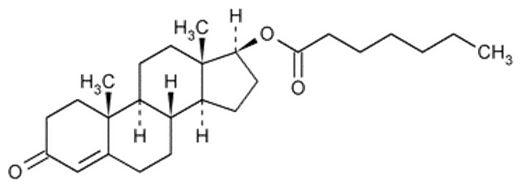
XYOSTED (testosterone enanthate) injection is a sterile, preservative-free, and nonpyrogenic colorless to pale yellow solution supplied in a single-dose syringe assembled in a pressure-assisted autoinjector for subcutaneous administration. Each XYOSTED autoinjector contains 50 mg, 75 mg, or 100 mg of testosterone enanthate dissolved in 0.5 mL of sesame oil providing three product strengths of 50 mg/0.5 mL, 75 mg/0.5 mL, and 100 mg/0.5 mL.
-
12 CLINICAL PHARMACOLOGY
12.1 Mechanism of Action
Endogenous androgens, including testosterone and dihydrotestosterone (DHT) are responsible for the normal growth and development of the male sex organs and for maintenance of secondary sex characteristics. These effects include the growth and maturation of the prostate, seminal vesicles, penis, and scrotum; the development of male hair distribution, such as facial, pubic, chest, and axillary hair; laryngeal enlargement, vocal cord thickening, and alterations in body musculature and fat distribution.
Male hypogonadism, a clinical syndrome resulting from insufficient secretion of testosterone, has two main etiologies. Primary hypogonadism is caused by defects of the gonads, such as Klinefelter’s syndrome or Leydig cell aplasia, whereas secondary hypogonadism is the failure of the hypothalamus (or pituitary) to produce sufficient gonadotropins (FSH, LH).
12.3 Pharmacokinetics
Absorption and Bioavailability
XYOSTED delivers physiologic amounts of testosterone, producing circulating testosterone concentrations that approximate normal concentrations (300-1100 ng/dL) seen in healthy men.
Following weekly subcutaneous injection of XYOSTED for 12 weeks, serum testosterone concentrations reached a maximum after a median of 11.9 hours post-dose (range: 5.8-168.7 hours) then slowly declined (Figure 1). In this study, the starting dose of XYOSTED was 75 mg weekly then the XYOSTED dose was adjusted based upon total testosterone trough concentrations obtained following 6 weeks of dosing [see Dosage and Administration (2.2)]. Steady state serum testosterone concentration was achieved by Week 6.
Figure 1. Mean (±SD) of Total Testosterone (TT) Concentration (ng/dL) Following Weekly Administration of XYOSTED for 12 Weeks (N=137)

At Week 12, total testosterone concentrations were measured before and at specified times up to 168 hours after XYOSTED administration then analyzed for pharmacokinetic (PK) parameters (Table 3).
Table 3. Arithmetic Mean (SD) and Range for Total Testosterone Pharmacokinetic Parameters at Week 12 Following Weekly Administration of 50 mg, 75 mg, or 100 mg XYOSTED (N=137)
Cavg (0-168 hr)
(ng/dL)
Cmax
(ng/dL)
Tmax
(hr)a
Cmin
(ng/dL)
AUC (0-168 hr)
(ng·hr/dL)
Mean (SD)
553 (127)
790 (215)
11.9
436 (109)
92,955 (21,385)
Min - Max
276 - 1036
389 - 1410
6 - 168
166 - 788
46432 - 173,987
a Reported as median
Distribution
Circulating testosterone is primarily bound in serum to sex hormone-binding globulin (SHBG) and albumin. Approximately 40% of testosterone in plasma is bound to SHBG, 2% remains unbound (free), and the rest is loosely bound to albumin and other proteins.
Elimination
Metabolism
Testosterone enanthate is metabolized to testosterone via ester cleavage of the enanthate group. The mean (SD) maximum concentration of testosterone enanthate was 169 (68) ng/dL at Week 12 following weekly administration of XYOSTED.
Testosterone is metabolized to various 17-keto steroids through two different pathways. The major active metabolites of testosterone are estradiol and dihydrotestosterone (DHT). At pre-dose of Week 12 treatment, the mean DHT/testosterone ratio was 0.07 which was within the normal range.
Excretion
About 90% of a testosterone dose given intramuscularly is excreted in the urine as glucuronic and sulfuric acid-conjugates of testosterone or as metabolites. About 6% of a dose is excreted in the feces, mostly in the unconjugated form. Inactivation of testosterone occurs primarily in the liver.
-
13 NONCLINICAL TOXICOLOGY
13.1 Carcinogenesis, Mutagenesis, Impairment of Fertility
Carcinogenicity
Testosterone has been tested by subcutaneous injection and implantation in mice and rats. In mice, the implant induced cervical-uterine tumors, which metastasized in some cases. There is suggestive evidence that injection of testosterone into some strains of female mice increases their susceptibility to hepatoma. Testosterone is also known to increase the number of tumors and decrease the degree of differentiation of chemically induced carcinomas of the liver in rats.
Mutagenicity
Testosterone was negative in the in vitro Ames and in the in vivo mouse micronucleus assays.
Impairment of Fertility
The administration of exogenous testosterone suppresses spermatogenesis in the rat, dog and non-human primates, which was reversible on cessation of the treatment.
-
14 CLINICAL STUDIES
XYOSTED was evaluated in a 52-week, open-label study (NCT02159469) to evaluate its efficacy and safety when administered subcutaneously once weekly to 150 adult males with hypogonadism. The study included a Screening Phase, a Treatment Titration Phase, and an Extended Treatment Phase.
Patients were trained on proper use of XYOSTED to self-administer the initial dose of 75 mg once weekly on the same day of the week and at approximately the same time (7:00 am ± 2 hours). The dose was increased by 25 mg at Week 7 if the Week 6 serum total testosterone concentration at the end of the dosing interval (Ctrough) was <350 ng/dL, and was decreased by 25 mg if the Ctrough was ≥650 ng/dL.
The primary endpoint was the percentage of patients with a time-averaged serum total testosterone concentration (Cavg) over the 7-day dosing interval (0 to 168 hours) within the normal range (300 to 1100 ng/dL) at Week 12.
Secondary endpoints were the percentage of patients with a maximum total testosterone concentration (Cmax) above three predetermined limits: greater than 1500 ng/dL, between 1800 and 2500 ng/dL, and greater than 2500 ng/dL.
One hundred and thirty five (90%) of the 150 hypogonadal men who received XYOSTED had a serum total testosterone concentration Cavg(0-168h) within the normal range (300 to 1100 ng/dL) at Week 12. There were no patients (0%) with Cmax >1500 ng/dL at Week 12.
-
16 HOW SUPPLIED/STORAGE AND HANDLING
16.1 How Supplied
XYOSTED (testosterone enanthate) injection is provided as 0.5 mL of a sterile, preservative-free, and nonpyrogenic colorless to pale yellow solution in a single-dose syringe pre-assembled in an autoinjector for a single subcutaneous administration. XYOSTED is packaged in cartons containing four (4) autoinjectors. XYOSTED is available in the following strengths and configurations.
- XYOSTED (testosterone enanthate) injection, USP, 50 mg/0.5 mL
- Carton of 4 autoinjectors NDC 54436-250-04
- Autoinjector NDC 54436-250-02
- XYOSTED (testosterone enanthate) injection, USP, 75 mg/0.5 mL
- Carton of 4 autoinjectors NDC 54436-275-04
- Carton of 1 autoinjector NDC 54436-275-05
- Autoinjector NDC 54436-275-02
- XYOSTED (testosterone enanthate) injection, USP, 100 mg/0.5 mL
- Carton of 4 autoinjectors NDC 54436-200-04
- Carton of 1 autoinjector NDC 54436-200-05
- Autoinjector NDC 54436-200-02
Before use, each autoinjector should be visually inspected. XYOSTED should be clear to light yellow in color and free of visible particles. Do not use if the liquid is cloudy or if visible particles are present. You may notice an air bubble, this is normal.
- XYOSTED (testosterone enanthate) injection, USP, 50 mg/0.5 mL
-
17 PATIENT COUNSELING INFORMATION
Advise the patient to read the FDA-approved patient labeling (Medication Guide and Instructions for Use).
Increased Blood Pressure and Risk for Major Adverse Cardiovascular Events (MACE)
- Inform patients that XYOSTED can increase BP that can increase the risk for MACE, including myocardial infarction, stroke, and cardiovascular death.
- Instruct patients about the importance of monitoring BP periodically while on XYOSTED. If BP increases while on XYOSTED, antihypertensive medications may need to be started, added, or adjusted to control BP, or XYOSTED may need to be discontinued.
Other Adverse Reactions
Inform patients that treatment with androgens may lead to adverse reactions which include:
- Changes in urinary habits related to effects on prostate size, such as increased urination at night, hesitancy, urinary frequency, urinary urgency, having a urine accident, or being unable to pass urine or weak urine flow.
- Breathing disturbances that may reflect obstructive sleep apnea, including those associated with sleep or excessive daytime sleepiness.
- Too frequent or persistent erections of the penis.
- Ankle swelling that may reflect peripheral edema.
- Red blood cell count increase, PSA increase, injection site bruising, injection site bleeding.
Instruct patients to report any changes in their state of health, such as changes in urinary habits, breathing, sleep, and mood, including new onset or worsening of depression, or suicidal ideation.
Keep XYOSTED out of the reach of children
For more information call: 1-844-XYOSTED (1-844-996-7833) or visit www.XYOSTED.com
Manufactured For: Antares Pharma, Inc. Ewing, NJ 08628
XYOSTED is a trademark of Antares Pharma, Inc.
©2022 Antares Pharma, Inc. All rights reserved
-
MEDICATION GUIDE
MEDICATION GUIDE
XYOSTEDTM (ZYE-oh-sted)
(testosterone enanthate) injection, for subcutaneous use CIII
What is the most important information I should know about XYOSTED?
- XYOSTED can increase your blood pressure, which can increase your risk of having a heart attack or stroke and can increase your risk of death due to a heart attack or stroke. Your risk may be greater if you have already had a heart attack or stroke or if you have other risk factors for heart attack or stroke.
- If your blood pressure increases while you are on XYOSTED, blood pressure medicines may need to be started. If you are already taking blood pressure medicines, new blood pressure medicines may need to be added or your current blood pressure medicines may need to be changed to control your blood pressure.
- If your blood pressure cannot be controlled, XYOSTED may need to be stopped.
- Your healthcare provider will monitor your blood pressure while you are being treated with XYOSTED.
What is XYOSTED?
XYOSTED is a prescription medicine that contains testosterone. XYOSTED is used to treat adult men who have low or no testosterone due to certain medical conditions.
It is not known if XYOSTED is safe and effective in children younger than 18 years old. Improper use of XYOSTED may affect bone growth in children.
XYOSTED is a controlled substance (CIII) because it contains testosterone that can be a target for people who abuse prescription medicines. Keep your XYOSTED in a safe place to protect it. Never give your XYOSTED to anyone else, even if they have the same symptoms you have. Selling or giving away this medicine may harm others and it is against the law.
XYOSTED is not meant for use by women.
Do not take XYOSTED if you:
- are a man who has breast cancer.
- have or might have prostate cancer.
- are a woman who is pregnant. XYOSTED may harm your unborn baby.
- are allergic to XYOSTED or to any ingredients in XYOSTED including testosterone or sesame oil.
- have low testosterone without certain medical conditions. For example, do not take XYOSTED if you have low testosterone due to age.
Before you use XYOSTED, tell your healthcare provider about all your medical conditions, including, if you:
- have high blood pressure or heart problems.
- have high red blood cell count (hematocrit) or high hemoglobin laboratory value.
- have urinary problems due to an enlarged prostate.
- have heart problems.
- have kidney or liver problems.
- have a history of mental health illness including suicidal thoughts or actions, depression, anxiety or mood disorder.
- have problems breathing while you sleep (sleep apnea).
Tell your healthcare provider about all the medicines you take, including prescription and nonprescription medicines, vitamins, and herbal supplements.
Using XYOSTED with other medicines can affect each other. Especially, tell your healthcare provider if you take:
- insulin
- medicines that decrease blood clotting (blood thinners)
- corticosteroids
- medicines for pain and cold.
Know the medicines you take. Ask your healthcare provider or pharmacist for a list of all your medicines if you are not sure. Keep a list of them and show it to your healthcare provider and pharmacist when you get a new medicine.
How should I use XYOSTED?
- See the detailed Instructions for Use for information about how to use XYOSTED.
- Use XYOSTED exactly as your healthcare provider tells you to take it.
- Your healthcare provider will show you or your caregiver how to inject XYOSTED. You should not inject XYOSTED until you have been trained on the proper way to use it.
What are the possible side effects of XYOSTED?
XYOSTED can cause serious side effects including:
- See “What is the most important information I should know about XYOSTED?”
-
Increase in blood pressure.
- XYOSTED can increase your blood pressure, which can increase your risk of having a heart attack or stroke and can increase your risk of death due to heart attack or stroke. Your risk may be greater if you have already had a heart attack or stroke or if you have other risk factors for heart attack or stroke.
- You may need to start new medicines or have medicines changed for high blood pressure while on XYOSTED.
- Your healthcare provider should check your blood pressure while you use XYOSTED.
-
Increase in red blood cell count (hematocrit) or hemoglobin.
- XYOSTED increases red blood cell counts in some patients. High red blood cell counts increase the risk of clots, strokes, and heart attacks.
- You may need to stop XYOSTED if your red blood cell count increases.
- Your healthcare provider should check your red blood cell count and hemoglobin while you use XYOSTED.
-
If you already have an enlarged prostate, your signs and symptoms may get worse while using XYOSTED. This can include:
- increased urination at night
- trouble starting your urine stream
- having to pass urine many times during the day
- having an urge that you have to go to the bathroom right away
- having a urine accident
- being unable to pass urine or weak urine flow
- Increased risk of prostate cancer. Your healthcare provider should check you for prostate cancer or any other prostate problems before you start and while you use XYOSTED.
- Blood clots in the legs or lungs. Signs and symptoms of a blood clot in your leg can include leg pain, swelling or redness. Signs and symptoms of a blood clot in your lungs can include difficulty breathing or chest pain.
- Abuse. Testosterone can be abused, when taken at higher than prescribed doses and when used with other anabolic androgenic steroids. Abuse can cause serious heart and psychological side effects. Your healthcare provider should check you for signs of abuse before and during treatment with XYOSTED.
- In large doses XYOSTED may lower your sperm count.
-
Liver problems. Symptoms of liver problems may include:
- nausea or vomiting
- yellowing of your skin or whites of your eyes
- dark urine
- pain on the right side of your stomach area (abdominal pain)
- Swelling of your ankles, feet, or body, with or without heart failure.
- Enlarged or painful breasts.
- Problems breathing while you sleep (sleep apnea).
- Change in mood. Talk to your healthcare provide if you have changes in mood or behavior including, new or worsening depression, or suicidal thoughts.
Call your healthcare provider right away if you have any of the serious side effects listed above.
The most common side effects of XYOSTED include:
- red blood cell count increase
- prostatic specific antigen (PSA) increase (a test used to screen for prostate cancer)
- high blood pressure
- injection site reactions including:
- bruising
- bleeding
- redness
- hardness
Other side effects include more erections than are normal for you or erections that last a long time.
Tell your healthcare provider if you have any side effect that bothers you or that does not go away.
These are not all the possible side effects of XYOSTED. For more information, ask your healthcare provider or pharmacist. Call your doctor for medical advice about side effects. You may report side effects to FDA at 1-800-FDA-1088.
How should I store XYOSTED?
Do not refrigerate or freeze. Use at room temperature.
Store at controlled room temperature, 68°F to 77°F (20°C to 25°C). Protect from light (keep in carton until time of use).
Keep XYOSTED and all medicines out of the reach of children.
General information about the safe and effective use of XYOSTED.
Medicines are sometimes prescribed for purposes other than those listed in a Medication Guide. Do not use XYOSTED for a condition for which it was not prescribed. Do not give XYOSTED to other people, even they have the same symptoms that you have. It may harm them. You can ask your pharmacist or healthcare provider for information about XYOSTED that is written for health professionals.
What are the ingredients in XYOSTED?
Active ingredient: testosterone enanthate
Inactive ingredients: sesame oil
Manufactured by:
Antares Pharma, Inc. Ewing, NJ 08628 XYOSTED is a trademark of Antares Pharma, Inc. ©2018 Antares Pharma, Inc. All rights reserved
For more information, go to www.XYOSTED.com or call 1-844-XYOSTED (1-844-996-7833).
This Medication Guide has been approved by the U.S. Food and Drug Administration. Issued: 02/2022
-
Instructions for Use
XYOSTEDTM
Testosterone Enanthate Injection USP CIIISingle-use.
For subcutaneous injection.
Administer one device weekly.Read this Instructions for Use before you start using XYOSTED (ZYE-oh-sted) and each time you get a refill. There may be new information. This leaflet does not take the place of talking with your healthcare provider about your medical condition or treatment.
Important Information about XYOSTED:
- Use XYOSTED exactly as your healthcare provider tells you to take it.
- Inject XYOSTED only 1 time each week. Do not use XYOSTED every day.
- Your healthcare provider will show you or your caregiver how to inject XYOSTED. You should not inject XYOSTED until you have been trained on the proper way to use it.
- Check XYOSTED before you inject it. XYOSTED should be clear to light yellow in color and should be free of visible particles.
- Do not use if the liquid is cloudy or if visible particles are present. You may see air bubble(s), this is normal.
- Do not use XYOSTED if the safety seal is broken or if the Auto-Injector appears broken, damaged or changed in any way.
- XYOSTED should be injected in the stomach (abdomen) area after cleaning the skin.
- Do not inject XYOSTED within 2 inches of the belly button (navel).
- Do not inject XYOSTED in any other areas of the body.
- Do not inject XYOSTED in areas where the skin is tender, bruised, red, scaly, hard, or has scars or stretch marks.
If you are not sure if XYOSTED was injected, or if you have a hard time giving the injection, do not inject another dose. Call your pharmacist or healthcare provider right away.
If you need help or instructions, call:
1-844-996-7833- Carefully read all steps before beginning injection.
- Injection process must be completed without interruption.
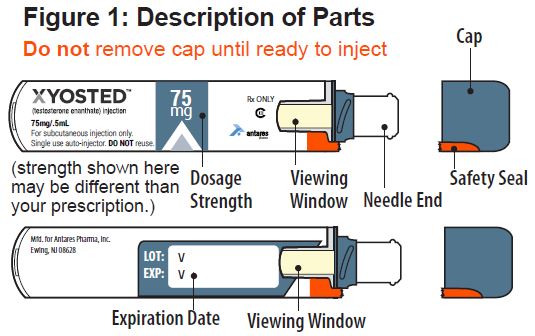
Supplies You Will Need
- 1 XYOSTED Auto-Injector
- 1 alcohol swab
- 1 cotton ball or gauze
Storage Conditions
- Do not refrigerate or freeze.
- Protect from light.
- Use at room temperature.
- Store at 68° - 77° F (20° - 25° C).
- Keep XYOSTED and all medicines away from children.
Inspect Auto-Injector
- Do not remove Cap until ready to inject.
- Inspect Auto-Injector for any visible damage. Do not use if it appears damaged or broken.
- Check the expiration date. Do not use if the expiration date has passed.
- Inspect the medicine through the Viewing Window; it should be clear to light yellow and free of visible particles (see Figure 2).
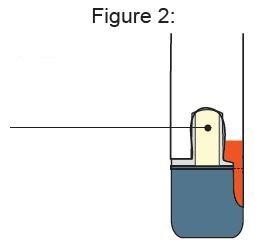
Do not use if the medicine is cloudy or if visible particles are present. You may notice an air bubble, this is normal.
Select & Prep Injection Site
Wash your hands with soap and water.
Wipe the abdomen injection site with an alcohol swab.
Allow the site to dry on its own.
Do not fan or blow on the injection site.
Do not touch the site again before injecting.
Only use the left or right side of the abdomen (belly) for injection sites.
Do not use the area within 2 inches around your navel (belly button).
See Figure 3.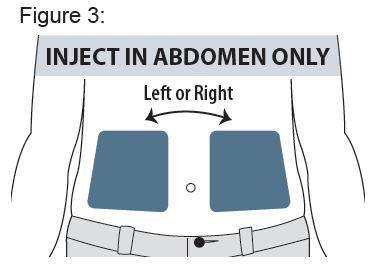
Do not use in areas where the skin is tender, bruised, red, scaly, or hard. Avoid areas with scars, tattoos, or stretch marks.
Administering Injection
1. Remove Cap
Twist the Cap to remove (this will also break the red safety seal). See Figure 4.
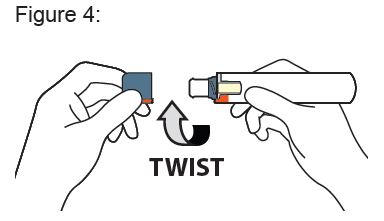
After the Cap is removed, a few drops of liquid may appear, this is normal.
The Auto-Injector should be used or discarded after the Cap is removed.
Do not re-Cap for later use.
Do not touch the Needle End of the Auto-Injector with your hand or fingers after the Cap is removed, doing so can cause injection and injury to your hands.
2. Position Auto-Injector
Gently squeeze the abdomen injection site to create a raised area and hold that area firmly until after the injection is complete (see Figure 5).
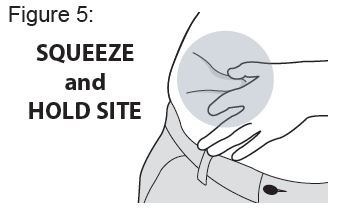
Place the Needle End of the Auto-Injector on the abdomen injection site.
Keep the Auto-Injector straight at a 90 degree angle to the abdomen injection site. (see Figure 6).
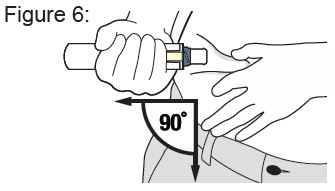
3. Inject & Hold Down
Firmly push the Auto-Injector down on the abdomen site and continue to hold down after you hear the “CLICK” (see Figure 7).
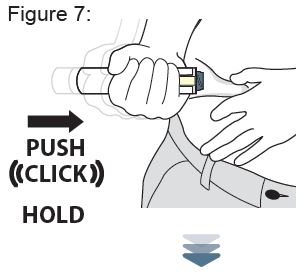
While holding the XYOSTED Auto-Injector down, slowly count from 1 to 10 to allow all of the medicine to be delivered (see Figure 8).
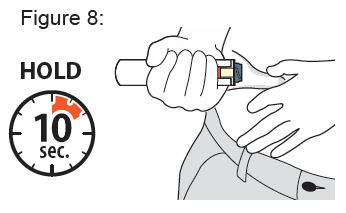
Keep holding the XYOSTED Auto-Injector down for a total of 10 seconds even if your injection is complete and the viewing window turns orange sooner.
It is normal if there is slight bleeding from the site after injection. If this occurs, hold a cotton ball or gauze on the area for a few seconds. Do not rub the area.
4. Inspect Viewing Window
After injecting, inspect the Viewing Window. It should be orange, confirming the dose was administered (see Figure 9).
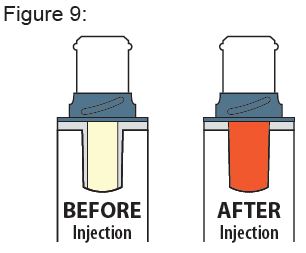
If the Viewing Window is not orange:
- Do not use another Auto-Injector.
- Do not attempt another injection.
- Call your healthcare provider or 1-844-996-7833 for assistance.

Disposal After Injection

After completing your injection, dispose of the XYOSTED Auto-Injector and Cap in an FDA-cleared sharps disposal container immediately after use.
Do not dispose of the XYOSTED Auto-Injector in your household trash.
If you do not have an FDA-cleared sharps disposal container, you may use a household container that is:
- made of a heavy-duty plastic
- can be closed with a tight-fitting, puncture-resistant lid, without sharps being able to come out
- upright and stable during use
- leak-resistant
- properly labeled to warn of hazardous waste inside the container
When your sharps disposal container is almost full, you will need to follow your community guidelines for the proper way to dispose of your sharps disposal container. There may be state or local laws about how you should throw away used needles and syringes. For more information about safe sharps disposal in the state that you live in, go to the FDA’s website at: http://www.fda.gov/safesharpsdisposal.
Do not dispose of your used sharps disposal container in your household trash unless your community guidelines permit this. Do not recycle your used sharps disposal container.
This Instructions for Use has been approved by the U.S. Food and Drug Administration
LB-0118 V6
Manufactured for:
Antares Pharma, Inc.
Ewing, NJ 08628
08/2023 - PRINCIPAL DISPLAY PANEL - 50 mg/0.5 mL Autoinjector
- PRINCIPAL DISPLAY PANEL - 75 mg/0.5 mL Autoinjector
- PRINCIPAL DISPLAY PANEL - 100 mg/0.5 mL Autoinjector
- PRINCIPAL DISPLAY PANEL - 50 mg/0.5 mL Carton
- PRINCIPAL DISPLAY PANEL - 75 mg/0.5 mL Carton
- PRINCIPAL DISPLAY PANEL - 100 mg/0.5 mL Carton
-
INGREDIENTS AND APPEARANCE
XYOSTED
testosterone enanthate injectionProduct Information Product Type HUMAN PRESCRIPTION DRUG Item Code (Source) NDC:54436-250 Route of Administration SUBCUTANEOUS DEA Schedule CIII Active Ingredient/Active Moiety Ingredient Name Basis of Strength Strength TESTOSTERONE ENANTHATE (UNII: 7Z6522T8N9) (TESTOSTERONE - UNII:3XMK78S47O) TESTOSTERONE ENANTHATE 50 mg in 0.5 mL Inactive Ingredients Ingredient Name Strength SESAME OIL (UNII: QX10HYY4QV) Packaging # Item Code Package Description Marketing Start Date Marketing End Date 1 NDC:54436-250-04 4 in 1 CARTON 11/15/2018 1 NDC:54436-250-02 0.5 mL in 1 SYRINGE; Type 2: Prefilled Drug Delivery Device/System (syringe, patch, etc.) 2 NDC:54436-250-01 1 in 1 CARTON 11/15/2018 2 NDC:54436-250-03 0.5 mL in 1 SYRINGE; Type 2: Prefilled Drug Delivery Device/System (syringe, patch, etc.) Marketing Information Marketing Category Application Number or Monograph Citation Marketing Start Date Marketing End Date NDA NDA209863 11/15/2018 XYOSTED
testosterone enanthate injectionProduct Information Product Type HUMAN PRESCRIPTION DRUG Item Code (Source) NDC:54436-275 Route of Administration SUBCUTANEOUS DEA Schedule CIII Active Ingredient/Active Moiety Ingredient Name Basis of Strength Strength TESTOSTERONE ENANTHATE (UNII: 7Z6522T8N9) (TESTOSTERONE - UNII:3XMK78S47O) TESTOSTERONE ENANTHATE 75 mg in 0.5 mL Inactive Ingredients Ingredient Name Strength SESAME OIL (UNII: QX10HYY4QV) Packaging # Item Code Package Description Marketing Start Date Marketing End Date 1 NDC:54436-275-04 4 in 1 CARTON 11/15/2018 1 NDC:54436-275-02 0.5 mL in 1 SYRINGE; Type 2: Prefilled Drug Delivery Device/System (syringe, patch, etc.) 2 NDC:54436-275-05 1 in 1 CARTON 01/08/2024 2 NDC:54436-275-02 0.5 mL in 1 SYRINGE; Type 2: Prefilled Drug Delivery Device/System (syringe, patch, etc.) 3 NDC:54436-275-01 1 in 1 CARTON 11/15/2018 3 NDC:54436-275-03 0.5 mL in 1 SYRINGE; Type 2: Prefilled Drug Delivery Device/System (syringe, patch, etc.) Marketing Information Marketing Category Application Number or Monograph Citation Marketing Start Date Marketing End Date NDA NDA209863 11/15/2018 XYOSTED
testosterone enanthate injectionProduct Information Product Type HUMAN PRESCRIPTION DRUG Item Code (Source) NDC:54436-200 Route of Administration SUBCUTANEOUS DEA Schedule CIII Active Ingredient/Active Moiety Ingredient Name Basis of Strength Strength TESTOSTERONE ENANTHATE (UNII: 7Z6522T8N9) (TESTOSTERONE - UNII:3XMK78S47O) TESTOSTERONE ENANTHATE 100 mg in 0.5 mL Inactive Ingredients Ingredient Name Strength SESAME OIL (UNII: QX10HYY4QV) Packaging # Item Code Package Description Marketing Start Date Marketing End Date 1 NDC:54436-200-04 4 in 1 CARTON 11/15/2018 1 NDC:54436-200-02 0.5 mL in 1 SYRINGE; Type 2: Prefilled Drug Delivery Device/System (syringe, patch, etc.) 2 NDC:54436-200-05 1 in 1 CARTON 01/08/2024 2 NDC:54436-200-02 0.5 mL in 1 SYRINGE; Type 2: Prefilled Drug Delivery Device/System (syringe, patch, etc.) 3 NDC:54436-200-01 1 in 1 CARTON 11/15/2018 3 NDC:54436-200-03 0.5 mL in 1 SYRINGE; Type 2: Prefilled Drug Delivery Device/System (syringe, patch, etc.) Marketing Information Marketing Category Application Number or Monograph Citation Marketing Start Date Marketing End Date NDA NDA209863 11/15/2018 Labeler - Antares Pharma, Inc. (085369585)

